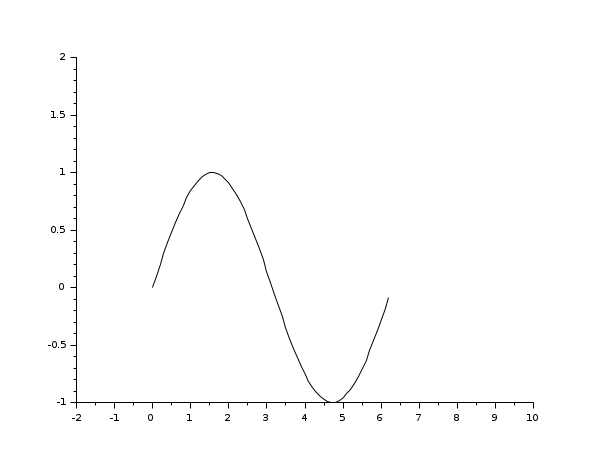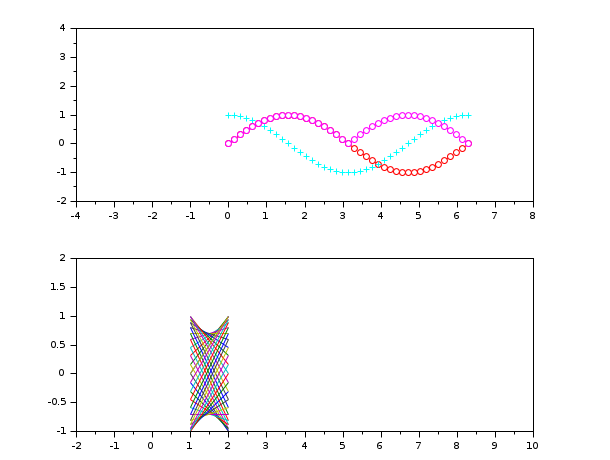Please note that the recommended version of Scilab is 2026.0.0. This page might be outdated.
See the recommended documentation of this function
replot
redraw with new boundaries the current or a given set of axes
Syntax
replot() replot(area) replot(idAxes) replot(area, idAxes) replot(.., tight_limits)
Arguments
- area
row vector [xmin ymin xmax ymax] or [xmin ymin zmin xmax ymax zmax]: new bounds of the area to be replotted.
The default area is [%inf %inf %inf %inf] for a 2D axes, or [%inf %inf %inf %inf %inf %inf] for a 3D one.
%nancan be used to keep a bound as is.%infcan be used to set a bound to the position of the most marginal graphical component existing in the axes, for the considered direction.
If N axes are identified in
idAxes,areamay be a matrix with N rows and 4 or 6 columns. The row #i is then related to the axes #i ofidAxes. Ifareais only a vector of 4 or 6 bounds, these ones are used for all axes to be reframed.- idAxes
Vector of graphic handles, expected to be of Axes type or to have direct children of type Axes, such as Figures or some frame uicontrols.
idAxesspecifies direct or children Axes to crop. If no axes is found, nothing is done.By default, the current Axes is considered.
- tight_limits
Single word
"tight"or"on"or"off", or vector of 2 (in 2D) or 3 (in 3D) words"tight"or"on"or"off". If a single word is provided, it is used for every axis. This option forces the.tight_limitsattribute of considered axes to the specified"on"or"off"values. By default, current limits modes are unchanged.
Description
replot is used to reframe the (set of) axes specified
with idAxes -- or by default the current axes --
with new boundaries defined by
area = [xmin,ymin, xmax,ymax] or
area = [xmin,ymin,zmin, xmax,ymax,zmax].
It changes the data_bounds attribute of processed axes.
When a specified bound is infinite (%inf and -%inf are equivalent),
replot looks for the most marginal graphical object
and sets the actual related bound to its position, taking also
objects sizes into account. This ensures not clipping any object
that would be beyond the targeted side of the axes.
When the tight_limits option is provided,
its value is assigned to the .tight_limits
attribute of each considered axes, in an axis-wise way.
Examples

xdel(winsid()); plot() // plot demo f = gcf(); replot([-1,-1,10,2],f.children(1)) // specify axes handle's value replot([-3,-2,8,4],f.children(2))

// Leaving some bounds as is with %nan: x = linspace(0,360,200).'; clf plot2d(x,[sind(x) tand(x)]) ax = gca(); ax.data_bounds // initial bounds replot([%nan,-10,%nan,10]) // only Ymin and Ymax are changed ax.data_bounds // updated bounds
See also
- zoom_rect — zoom a selection of the current graphic figure
- rubberbox — rubberband box for rectangle selection
- axes_properties — description of the axes entity properties
History
| Version | Description |
| 5.5.0 |
|
| 6.0 |
|
| Report an issue | ||
| << plotframe | axes_operations | rotate_axes >> |